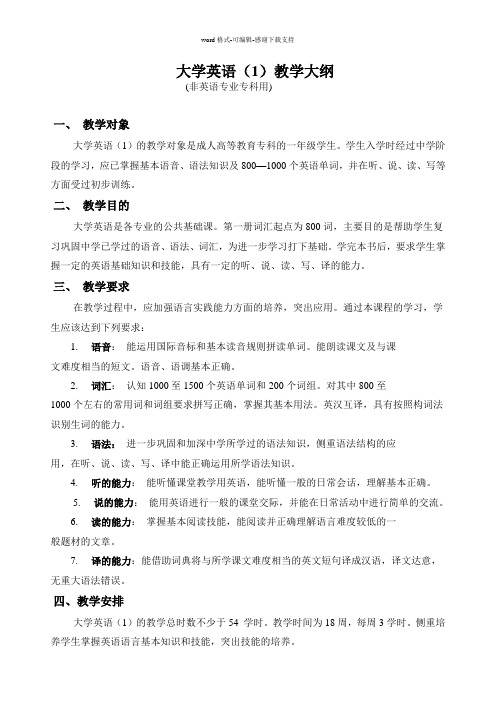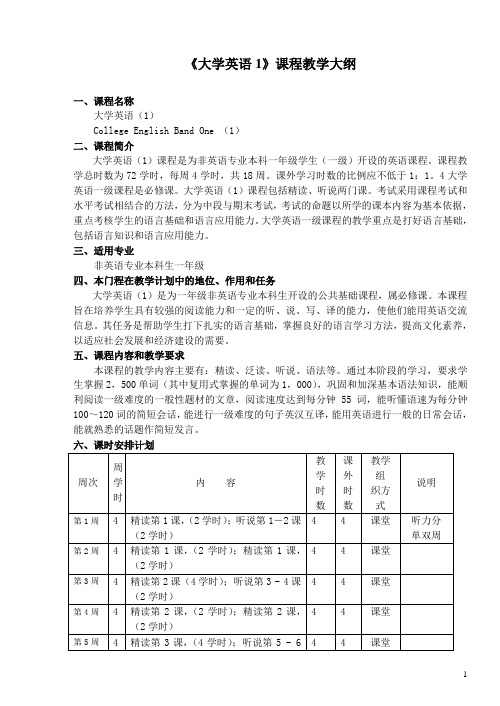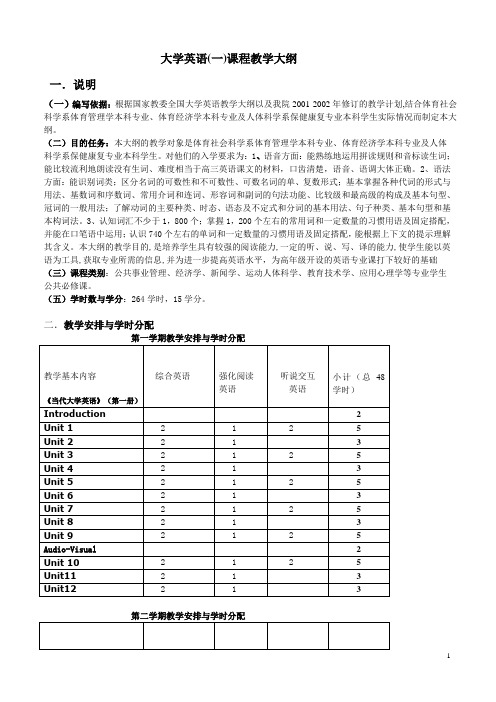《大学英语1》课程教学大纲
《大学英语1》教学大纲

《大学英语》教学大纲一、课程类别任意选修二、教学目的大学英语是成人高等教育中一门重要的基础课程,着重对学生进行英语基本技能训练,培养学生使用英语进行人际沟通的能力。
学生毕业后应具备职业岗位所需要的一定的听说能力、较强的阅读和翻译本专业的一般技术资料的能力、书写常用专业应用文的能力,并为今后学习和运用英语打下较为扎实的基础。
本课程在加强英语语言基础知识和基本技能训练的同时,重视培养学生实际使用英语进行交际的能力。
通过本课程的学习,学生应该达到下列要求:1.词汇认知3400个英语单词(包括入学时要求掌握的1600个词)以及由这些词构成的常用词组,对其中2000个左右的单词能正确拼写,英汉互译。
学生还应结合专业英语学习,认知400个专业英语词汇。
2.语法掌握基本的英语语法规则,在听、说、读、写、译中能正确运用所学语法知识。
3.听力能听懂日常和涉外业务活动中使用的结构简单、发音清楚、语速较慢(每分钟120词左右)的英语对话和不太复杂的陈述,理解基本正确。
4.口语能用英语进行一般的课堂交际,并能在日常和涉外业务活动中进行简单的交流。
5.阅读能阅读中等难度的一般题材的简短英文资料,理解正确。
在阅读生词不超过总词数3%的英文资料时,阅读速度不低于每分钟70词。
能读懂通用的简短实用文字材料,如信函、技术说明书、合同等,理解正确。
6.写作能就一般性题材,在30分钟内写出80-100词的命题作文;能填写和模拟套写简短的英语应用文,如填写表格与单证,套写简历、通知、信函等,词句基本正确,无重大语法错误,格式恰当,表达清楚。
7、翻译(英译汉)能借助词典将中等难度的一般题材的文字材料和对外交往中的一般业务文字材料译成汉语。
理解正确,译文达意,格式恰当。
在翻译生词不超过总词数5%的实用文字材料时,笔译速度每小时250个英语词。
三、开课对象各专业函授(业余)本科学生四、学时分配总学时:210 其中面授:30学时自学:180学时五、教学内容与基本要求、教学的重点和难点【第二学期面授:12学时;自学:72学时】Unit 1 College Life1.听与说Introducing yourselfBy listening to the conversations between two new college students who meet at campus, learn the way to introduce yourself and tell your class your name, your age, where you come from, when you began to learn English and what you like to do on weekends.2.阅读与探究For many people, college life is a new experience. They feel excited and at the same time a bit worried. How did you feel whne you first got to the college? Name three things that you felt excited about and three things you felt a bit worried about.Then read the text in detail and make analysis of it.Reading for the main idea: topic sentence.英语段落的中心思想常用主题句表达。
大学英语(1)教学大纲

大学英语(1)教学大纲(非英语专业专科用)一、教学对象大学英语(1)的教学对象是成人高等教育专科的一年级学生。
学生入学时经过中学阶段的学习,应已掌握基本语音、语法知识及800—1000个英语单词,并在听、说、读、写等方面受过初步训练。
二、教学目的大学英语是各专业的公共基础课。
第一册词汇起点为800词,主要目的是帮助学生复习巩固中学已学过的语音、语法、词汇,为进一步学习打下基础。
学完本书后,要求学生掌握一定的英语基础知识和技能,具有一定的听、说、读、写、译的能力。
三、教学要求在教学过程中,应加强语言实践能力方面的培养,突出应用。
通过本课程的学习,学生应该达到下列要求:1.语音:能运用国际音标和基本读音规则拼读单词。
能朗读课文及与课文难度相当的短文。
语音、语调基本正确。
2.词汇:认知1000至1500个英语单词和200个词组。
对其中800至1000个左右的常用词和词组要求拼写正确,掌握其基本用法。
英汉互译,具有按照构词法识别生词的能力。
3.语法:进一步巩固和加深中学所学过的语法知识,侧重语法结构的应用,在听、说、读、写、译中能正确运用所学语法知识。
4.听的能力:能听懂课堂教学用英语,能听懂一般的日常会话,理解基本正确。
5.说的能力:能用英语进行一般的课堂交际,并能在日常活动中进行简单的交流。
6.读的能力:掌握基本阅读技能,能阅读并正确理解语言难度较低的一般题材的文章。
7.译的能力:能借助词典将与所学课文难度相当的英文短句译成汉语,译文达意,无重大语法错误。
四、教学安排大学英语(1)的教学总时数不少于54 学时。
教学时间为18周,每周3学时。
侧重培养学生掌握英语语言基本知识和技能,突出技能的培养。
五、测试测试是教学的一个重要环节,目的在于考核学生运用语言的能力。
本课程教学结束后由任课教师自行命题考试。
六、教学中要注意的几个问题1. 成人高等教育的培养目标是社会工作中的应用型专门人才。
打好语言基础是本课程的重要目标,在打好语言基础的同时,更要注重实际使用语言技能的培养。
《大学英语1》教学大纲

《大学英语(1)》教学大纲(执笔人:稂建中审阅单位:外国语学院大学外语教学中心)一、课程基本信息二、课程概述中文:《大学英语》课程为面向我校非英语专业本科生的公共通识必修课程系列,基于教学内容和能力培养目标分为1-4级;每单元围绕特定主题,通过听、说、读、写、译等语言活动,采用任务式教学方法和翻转课堂教学模式,利用现代信息通讯技术构建线上和线下相结合的多元立体学习环境;旨在提高学生的英语语言熟练程度、策略能力、跨文化意识和学习自主性。
具体地说,通过《大学英语1》的学习,学生能针对大学校园生活相关的通用主题,获取并运用听力策略提高听力理解能力;提高获取信息并理解主旨和重要细节的能力;掌握词汇构成知识,领会相关中西语言和文化差异,熟练运用基本的表达方式,翻译和写作基本文体段落,培养思辨能力和创新能力,提升英语综合应用能力和跨文化交际能力。
英文:"College English" Series are compulsory courses of general education for non-English majors, including four bands from 1 to 4 in terms of different teaching content and goals. Each course is themed-based and task-based, delivered through such activities as listening, speaking, reading, writing and translating, online or offline, incorporating information communication technology (ICT) into flipped-classroom teaching, aiming to promote the students’ English language proficiency, language learning strategies, awareness of cross-cultural communication and learner autonomy. To be more specific, College English (1) revolves around general topics relating to college campus life. By taking this course, the students are able to acquire and apply listening strategies so as to improve their listening comprehension, develop their capacity in acquiring information so as to understand the gist as well as key details, acquire and apply knowledge of word formation, recognize differences in language and culture between Chinese and English, learn to use English to express ideas on general topics, enhance their critical thinking and creativity, hence promote their English language proficiency and cross-cultural communication competence.三、课程内容(一)课程教学目标1. 能运用基本的听力技巧,能听懂熟悉话题的谈话等;2. 能正确运用基本的语言表达式描述事物以及表达观点、态度、情感等;3. 能读懂与大学生校园生活有关的一般性话题的文章,理解其大意及有关细节;4. 能就一般性话题在30分钟内写出80-100词左右的段落或篇章;5. 能运用正确的表达式翻译一般性话题的句子;6. 能掌握一定的学习策略并熟练运用;7. 具有一定的跨文化意识和一般性的跨文化交际能力。
大学英语1课程教学大纲

《大学英语1》课程教学大纲一、课程名称大学英语(1)College English Band One (1)二、课程简介大学英语(1)课程是为非英语专业本科一年级学生(一级)开设的英语课程。
课程教学总时数为72学时,每周4学时,共18周。
课外学习时数的比例应不低于1:1。
4大学英语一级课程是必修课。
大学英语(1)课程包括精读、听说两门课。
考试采用课程考试和水平考试相结合的方法,分为中段与期末考试,考试的命题以所学的课本内容为基本依据,重点考核学生的语言基础和语言应用能力。
大学英语一级课程的教学重点是打好语言基础,包括语言知识和语言应用能力。
三、适用专业非英语专业本科生一年级四、本门程在教学计划中的地位、作用和任务大学英语(1)是为一年级非英语专业本科生开设的公共基础课程,属必修课。
本课程旨在培养学生具有较强的阅读能力和一定的听、说、写、译的能力,使他们能用英语交流信息。
其任务是帮助学生打下扎实的语言基础,掌握良好的语言学习方法,提高文化素养,以适应社会发展和经济建设的需要。
五、课程内容和教学要求本课程的教学内容主要有:精读、泛读、听说、语法等。
通过本阶段的学习,要求学生掌握2,500单词(其中复用式掌握的单词为1,000),巩固和加深基本语法知识,能顺利阅读一级难度的一般性题材的文章,阅读速度达到每分钟55词,能听懂语速为每分钟100~120词的简短会话,能进行一级难度的句子英汉互译,能用英语进行一般的日常会话,能就熟悉的话题作简短发言。
六、课时安排计划七、习题课(无)八、实验内容(无)九、课程设计(无)十、教材与主要参考书1.精读课选用: 大学英语(全新版)综合教程(第一册),李荫华等主编,上海外语教育出版社出版,2002。
2.泛读课选用: 大学英语(全新版)阅读教程(第一册),柯彦玢等主编,上海外语教育出版社出版,2002。
3.听说课选用: 大学英语(全新版)听说教程(第一册),虞苏美等主编,上海外语教育出版社出版,2002。
大学英语1A级教学大纲

《大学英语1》A级课程教学大纲1.课程基本信息2.课程性质、地位和任务性质:大学英语教学是高等教育的一个有机组成部分,是非英语专业低、中年级(一、二年级)的一门必修课。
本课程专为我院非英语专业本科A级学生选用了《大学英语综合教程1-4》、《大学英语听说教程1-4》、《大学英语快速阅读1-4》。
《大学英语口语教程》。
大学英语教学是以英语语言知识与应用技能、学习策略和跨文化交际为主要内容,以外语教学理论为指导,以遵循语言教学和语言习得的客观规律为前提,集多种教学模式和教学手段为一体的教学体系。
本课程涵盖精读、听说及快速阅读。
这三部分相辅相成,因此,在本课程的教学实施过程中,既要处理三部分之间的分工、配合,又要保证其课程体系的科学性与完整性。
任务:本课程的基本任务是帮助学生打下较扎实的语言基础,掌握良好的语言学习方法,增强自主学习能力,提高综合文化素养,使他们具有较强的英语综合应用能力,特别是听说能力,能用英语有效地进行口头和书面的信息交流,以适应社会发展、经济建设和国际交流的需要。
目的:根据教育部关于大学英语课程教学的要求,本课程四册结束后,学生应达到英语四级。
3.课程基本要求及重点难点根据教育部关于大学英语课程教学的要求,本课程四册结束后,学生应达到英语四级,既以下方面的要求:1. 听力理解能力:能听懂英语授课,能听懂日常英语谈话和一般性题材的讲座,能听懂语速较慢(每分钟100 ~120词)的英语广播和电视节目,能掌握其中心大意,抓住要点。
能运用基本的听力技巧。
2. 口语表达能力:能在学习过程中用英语交流,并能就某一主题进行讨论,能就日常话题用英语进行交谈,能经准备后就所熟悉的话题作简短发言,表达比较清楚,语音、语调基本正确。
能在交谈中使用基本的会话策略。
3. 阅读理解能力:能基本读懂一般性题材的英文文章,阅读速度达到每分钟60词。
在快速阅读篇幅较长、难度略低的材料时,阅读速度达到每分钟90词。
能就阅读材料进行略读和寻读。
大学英语(一)课程教学大纲

大学英语(一)课程教学大纲一.说明(一)编写依据:根据国家教委全国大学英语教学大纲以及我院2001-2002年修订的教学计划,结合体育社会科学系体育管理学本科专业、体育经济学本科专业及人体科学系保健康复专业本科学生实际情况而制定本大纲。
(二)目的任务:本大纲的教学对象是体育社会科学系体育管理学本科专业、体育经济学本科专业及人体科学系保健康复专业本科学生。
对他们的入学要求为:1、语音方面:能熟练地运用拼读规则和音标读生词;能比较流利地朗读没有生词、难度相当于高三英语课文的材料,口齿清楚,语音、语调大体正确。
2、语法方面:能识别词类;区分名词的可数性和不可数性、可数名词的单、复数形式;基本掌握各种代词的形式与用法、基数词和序数词、常用介词和连词、形容词和副词的句法功能、比较级和最高级的构成及基本句型、冠词的一般用法;了解动词的主要种类、时态、语态及不定式和分词的基本用法、句子种类、基本句型和基本构词法。
3、认知词汇不少于1,800个;掌握1,200个左右的常用词和一定数量的习惯用语及固定搭配,并能在口笔语中运用;认识740个左右的单词和一定数量的习惯用语及固定搭配,能根据上下文的提示理解其含义。
本大纲的教学目的,是培养学生具有较强的阅读能力,一定的听、说、写、译的能力,使学生能以英语为工具,获取专业所需的信息,并为进一步提高英语水平,为高年级开设的英语专业课打下较好的基础(三)课程类别:公共事业管理、经济学、新闻学、运动人体科学、教育技术学、应用心理学等专业学生公共必修课。
(五)学时数与学分:264学时,15学分。
二.教学安排与学时分配第二学期教学安排与学时分配《当代大学英语综合英语》《当代大学英语听说交互英语》《当代大学英语强化阅读英语》第一册具体要求1.第一册的主要任务是阅读技巧、听说训练和段落写作。
写作的题目往往是已学的课文内容相关。
2.词汇:掌握580-630个词汇(其中18%可通过泛读和其他学习项目掌握)以及常用词组。
《大学英语1》教学大纲

《大学英语1》教学大纲一、课程目标通过本课程学习,使学生具备下列素养与能力:1.课程目标1:听力理解能力;(支撑毕业要求:沟通能力;跨文化交际能力)2.课程目标2:口语表达能力;(支撑毕业要求:沟通能力;跨文化交际能力)3.课程目标3:阅读理解能力;(支撑毕业要求:沟通能力;跨文化交际能力)4.课程目标4:书面表达能力;(支撑毕业要求:沟通能力;跨文化交际能力)5.课程目标5:翻译能力;(支撑毕业要求:沟通能力;跨文化交际能力)二、课程目标与毕业要求的对应关系三、教学内容、重难点和课时安排内容一《新视野大学英语读写教程1》(Unit 1-Unit 5)[周3学时,共42学时]。
重难点Unit 1Fresh Start1. 掌握重点词汇、短语及句式的用法。
2. 学会阅读技巧“Previewing”3. 把握文章结构,习得a topic sentence + details的写作方式重难点Unit 2 Loving Parents, Loving Children1. 掌握重点词汇、短语及句式的用法。
2. 学会阅读技巧“how to read in thought groups”3. 把握文章结构,习得problem-solution的写作方式重难点Unit 3 Digital Campus1. 掌握重点词汇、短语及句式的用法。
2. 学会阅读技巧“Distinguishing between facts and opinions”3. 把握文章结构,习得cause-effect的写作方式重难点Unit 4 Heroes of Our Time1. 掌握重点词汇、短语及句式的用法。
2. 学会阅读技巧“Scanning”3. 把握文章结构,习得question-example-conclusion的写作方式重难点Unit 5 Winning is Not Everything1. 掌握重点词汇、短语及句式的用法。
大学英语1全新版课程教学大纲

《大学英语1》课程教学大纲一、编写说明:1、课程英文名称:College English(全新版)2、课程编码:3、课程类型:必修课4、适用专业:非英语专业5、先行课程:无6、学时学分:52学时4学分7、考核方法:考试课程闭卷笔试8、使用教材:李荫华,王德明,夏国佐,余建中主编。
全新版《大学英语》(综合教程1)。
上海: 上海外语教育出版社,2001.虞苏美,李慧琴主编。
全新版《大学英语》(听说教程1)。
上海: 上海外语教育出版社,2001.郭杰克主编。
全新版《大学英语》(快速阅读1)。
上海: 上海外语教育出版社,2001. 9、本课程在教学中的地位和作用:大学英语课程是非英语专业大学生的一门必修基础课程。
大学英语的教学目的是让学生打好扎实的语言基本功,重视培养学生的英语综合应用能力,特别重视培养学生英语实际应用和交际能力,以便获取有关其专业的最新国际资料,从而开拓其专业视野及提高其专业技能,并使其在今后的工作和社会交往中能用英语有效地进行口头和书面的信息交流,同时培养和训练其自主学习能力,提高综合文化素养,以适应我国社会发展和国际交流的需要,使学生能够真正具有良好的国际交流能力。
10、本课程的基本任务和要求:1)、基本任务:本课程的基本任务是让学生在大学一年级第一学期内,修完全新版《大学英语》第一册的全部内容,重点在于语言知识的传授和语言能力的训练,并在此基础上适当地开阔学生视野,扩大学生知识面,加深学生对世界的了解,借鉴和吸收外国文化精华,提高学生的文化素养。
目标是使学生基本具备正确的语音、扎实的语法、一定的词汇量和基本的词汇运用能力,从而在听、说、读、写、译五个方面达到《大学英语教学大纲》的要求,为学生进入下一阶段学习打下坚实的基础。
2)、教学要求:本教学大纲在教学要求上分为一般要求阶段(一至二年级)和较高要求阶段(三至四年级),本课程属于一般要求阶段。
现将本课程的教学要求规定如下:1)词汇通过本课程的学习,学生的词汇量应增至2600左右,以及由这些词构成的常用词组(高中所掌握的单词和词组包括在内),并具有按照基本构词法识别生词的能力,精读量7,000词,泛读量24,000词左右。
本科《大学英语1》教学大纲

《大学英语1》课程教学大纲英文名称:New College English ( Second Edition)课程编号:06110040课程类别:必修总学时数:256(理论学时:实验或实践学时:)学分:16开课单位:衢州学院适用专业:本校非英语专业一年级本科生一、课程的性质、目的和任务1.课程性质大学英语课程是大学生的一门必修的基础课程。
大学英语教学是以英语语言知识与应用技能、学习策略和跨文化交际为主要内容,以外语教学理论为指导,并集多种教学模式和教学手段为一体的教学体系。
2.课程目标和任务大学英语基础阶段的教学目标是帮助学生打下较扎实的语言基础,掌握良好的语言学习方法,增强自主学习能力,提高综合文化素养,使他们具有较强的英语综合应用能力,特别是英语口头表达能力,能用英语有效地进行信息交流,以适应社会发展、经济建设和国际交流的需要。
二、课程教学内容及教学要求Unit One Growing Up1.教学内容1)Listening Task2) Text A Writing for Myself3) Text B The Scholarship Jacket4) Comprehensive Language Practice2.重点、难点重点:Comprehension of Text A难点:Master the words, expressions and sentence structures in Text A3.教学基本要求1) grasp the main idea ( the essence of writing is to write what one enjoys writing) and structure of Text A ( narration in Chronological sequence);2) appreciate the narrative skills demonstrated in Text A ( selection of details, repetition, coherence);3)master the key language points and learn how to use them in context;4)understand the cultural background related to the content;5)express themselves more freely on the theme of Growing up after doing aseries of theme-related reading, listening , speaking and writing activities;6)write a letter of congratulations in an appropriate way.Unit Two Friendship1.教学内容1)Listening Task2) Text A All the Cabbie Had Was a letter3) Text B Never Let a Friend Down4) Comprehensive Language Practice2.重点、难点重点:Comprehension of Text A难点:Master the words, expressions and sentence structures in Text A3.教学基本要求1) grasp the main idea (never delay expressing your true feelings to a friend ) and structure of Text A (developing a story around a letter);2) appreciate the narrative skills demonstrated in Text A ( spoken English is much more informal than written English);3) master the key language points and learn how to use them in context;4)understand the cultural background related to the content;5)express themselves more freely on the theme of Friendship after doing aseries of theme-related reading, listening , speaking and writing activities;6)write a personal letter in an appropriate way.Unit Three Understanding Science1.教学内容1)Listening Task2) Text A Public Attitudes Toward Science3) Text B How to Make Sense Out of Science4) Comprehensive Language Practice2.重点、难点重点:Comprehension of Text A难点:Master the words, expressions and sentence structures in Text A3.教学基本要求1) grasp the main idea (to ensure the survival of human civilization, measures must be taken to help the public understand science ) and structure of Text A ( introducing a topic, developing the topic with supporting details, drawing a conclusion);2) appreciate the narrative skills demonstrated in Text A (Text A, Unit 1) and expository writing (Text A, Unit 3);3) master the key language points and learn how to use them in context;4) understand the cultural background related to the content;5) express themselves more freely on the theme of Understanding Science after doing a series of theme-related reading, listening , speaking and writing activities;6) write an expository essay about how science changes our liveUnit Four The American Dream1.教学内容1)Listening Task2) Text A Tony Trivisonno’s American Dream3) Text B With His Own Two Hands4) Comprehensive Language Practice2.重点、难点重点:Comprehension of Text A难点:Master the words, expressions and sentence structures in Text A3.教学基本要求1) grasp the main idea Tony Trivisonno realized his American Dream through his own efforts) and structure of Text A (one part telling the story of Tony’s life and the other giving the author’s comments on it );2) learn to describe a person by his/her characteristic features, together with supporting details which demonstrate the features;3) master the key language points and learn how to use them in context;4) understand the cultural background related to the content;5) express themselves more freely on the theme of The American Dream after doing a series of theme-related reading, listening , speaking and writing activities;6) write a narrative in the third person singular about the story of Tony Trivisonno. Unit Five Work to Live or Live to Work1.教学内容1)Listening Task2) Text A The Company Man3) Text B You Might Be a Workaholic If …4) Comprehensive Language Practice2.重点、难点重点:Comprehension of Text A难点:Master the words, expressions and sentence structures in Text A3.教学基本要求1) grasp the main idea (the author tries to define a typical workaholic in the American corporate world with the story of Phil ) and structure of Text A;2) appreciate the narrative skills demonstrated in Text A (to set the tone of irony by choice of words, selection of details, use of quotation marks, etc.)3) master the key language points and learn how to use them in context;4) understand the cultural background related to the content;5) express themselves more freely on the theme of Work to Live or Live to Work after doing a series of theme-related reading, listening , speaking and writing activities;6) write a letter of sympathy or condolence in an appropriate wayUnit Six Romance1.教学内容1)Listening Task2) Text A A V alentine Story3) Text B The Wallet4) Comprehensive Language Practice2.重点、难点重点:Comprehension of Text A难点:Master the words, expressions and sentence structures in Text A3.教学基本要求1) grasp the main idea (the way one reacts to unattractive people reveals one’s true character) and structure of Text A2) appreciate the narrative skills demonstrated in Text A (switching between tenses ,change of narrators), some rhetorical devices (simile and metaphor) and the use of informal language in conversations3) master the key language points and learn how to use them in context;4) understand the cultural background related to the content;5) express themselves more freely on the theme of Romance after doing a series of theme-related reading, listening , speaking and writing activities;6) write a letter of invitation and acknowledgement in an appropriate wayUnit Seven Animal Intelligence1.教学内容1)Listening Task2) Text A What Animals Really Think3) Text B Do Animals Fall in love?4) Comprehensive Language Practice2.重点、难点重点:Comprehension of Text A难点:Master the words, expressions and sentence structures in Text A3.教学基本要求1) grasp the main idea (some animals seem capable of thinking when it is in their own interests to do so ) and structure of Text A ( introducing, 3 subheadings to give 3 supporting examples, conclusion);2) appreciate the importance of examples in exposition;3) master the key language points in Text A and learn how to use them in context;4) understand the cultural background related to the content;5) express themselves more freely on the theme of Animal Intelligence after doing a series of theme-related reading, listening , speaking and writing activities;6) write an essay about animal intelligence using relevant examples.Unit Eight Educational Problems1.教学内容1)Listening Task2) Text A A fable of the Lazy Teenager3) Text B Ditch the Calculator4) Comprehensive Language Practice2.重点、难点重点:Comprehension of Text A难点:Master the words, expressions and sentence structures in Text A3.教学基本要求1) grasp the main idea ( teenagers’ idleness and ignorance will seriously affect both themselves and society in general) and structure of Text A ( two parts-the author’s concern and his proposed remedy);2) learn how to write a cause-and-effect analysis;3) master the key language points and learn how to use them in context;4) understand the cultural background related to the content;5) express themselves more freely on the theme of Understanding Science after doing a series of theme-related reading, listening , speaking and writing activities;6) write an essay about the use of computers in schools using cause and effect.三、建议学时分配表四、课程考核方式与成绩评定1.考核方式:2.成绩评定:总评成绩构成:平时考核(20 )%;期中考核(20)%;期末考核(60 )%平时成绩构成:考勤考纪(10 )%;作业(10)%;实践环节()%五、建议教材及参考资料建议教材:×××主编,《×××》,××××出版社,××××年版1. 《全新版大学英语》(综合教程1)第二版李荫华主编,上海外语教育出版社,2010年版2. 《全新版大学英语》(听说教程1)第二版虞苏美主编,上海外语教育出版社,2010年版3. 《全新版大学英语》(快速阅读教程1册)第二版郭杰克主编,上海外语教育出版社,2010年版4. 《全新版大学英语》(综合教程1,一课一练)第二版李荫华主编,上海外语教育出版社,2010年版参考资料:1. 《全新版大学英语》(语法手册)第二版张成炜主编,上海外语教育出版社,2010年版2. 《大学英语四级模拟训练》权威出版社最新版本3. 《大学英语四级真题》权威出版社最新版本4. 《全新版大学英语》(综合教程1)第二版教师用书李荫华主编,上海外语教育出版社,2010年版5. 《全新版大学英语》(听说教程1)第二版教师用书虞苏美主编,上海外语教育出版社,2010年版六、大纲说明需要特殊表述的大纲中未尽事宜,如课程改革、整合情况等。
《大学英语一》教学大纲

《大学英语一》教学大纲课程名称:大学英语一英文名称:College English One课程编号:20110007学时数:60学时学分数:3学分适用专业:本课程适应于非英语、非音体美专业的其他各本科专业本教学大纲根据教育部《大学英语教学指南》(试行)制定,为通用英语课程,用于指导本校的大学英语教学,课程教学包括听、说、读、写、译五个部分。
一、课程的性质、目的和任务大学英语课程是高等教育非英语专业的一门公共必修课程,是高等学校人文教育的一部分,兼有工具性和人文性双重性质。
大学英语教学的目的是:培养学生英语听、说、读、写、译的语言技能,同时教授英语语音、词汇、语法、篇章及语用知识,增加学生的社会、文化、科学等基本知识,增强跨文化交际意识和交际能力,同时发展自主学习能力,提高综合文化素质,使他们在学习、生活、社会交往和未来工作中能够有效地使用英语,满足国际、社会、学校和个人发展的需要。
二、课程教学的基本要求1.听力理解能力能听懂就日常话题展开的简单英语交流;能基本听懂语速较慢(语速为每分钟120词左右)的音、视频材料和题材熟悉的讲座,掌握中心大意,抓住要点;能听懂用英语讲授的相应级别的英语课程;能听懂工作岗位相关的常用指令、产品或操作说明等;能运用基本的听力技巧。
2.口头表述能力能就日常话题用英语进行简短但多话轮的交谈;能对一般性实践和物体进行简短叙述或描述;经准备后能就所熟悉的话题作简短发言;能够就未来工作相关的主题进行简单讨论。
语言表达结构比较清楚,语音、语调、语法等基本符合交际规范。
能运用基本的会话技巧。
3.阅读理解能力能基本读懂题材熟悉、语言难度中等的英语报刊文章和其他英语材料;能借助词典阅读英语教材和未来工作、生活中常见的应用文和简单的专业资料,掌握中心大意,理解主要事实和有关细节;能够根据阅读目的的不同和阅读材料的难易,适当调整阅读速度和方法。
能运用基本的阅读技巧。
4.书面表达能力能用英语描述个人经历、观感、情感和发生的事件等;能写常见的应用文;能就一般性话题或提纲以短文形式展开简短的讨论、解释、说明等。
- 1、下载文档前请自行甄别文档内容的完整性,平台不提供额外的编辑、内容补充、找答案等附加服务。
- 2、"仅部分预览"的文档,不可在线预览部分如存在完整性等问题,可反馈申请退款(可完整预览的文档不适用该条件!)。
- 3、如文档侵犯您的权益,请联系客服反馈,我们会尽快为您处理(人工客服工作时间:9:00-18:30)。
《大学英语1》课程教学大纲一、基本信息课程编号:08A09010课程名称:大学英语1英文名称:College English I课程类型: ■通识必修课□通识核心课□通识选修课□学科基础课□专业基础课□专业必修课□专业选修课□实践环节总学时:48 讲课学时:48 实验学时:0学分:3适用对象:非英语专业一年级学生课程负责人:刘英杰梁爱民二、课程的性质与作用《大学英语1》的教学目的是培养学生具备综合应用英语的能力,培养学生具有较强的阅读能力和一定的听、说、写、译能力,使他们能用英语交流信息。
大学英语教学应帮助学生打下扎实的语言基础,掌握良好的语言学习方法,提高文化素养,以适应社会发展和经济建设的需要。
三、教学目标根据因材施教、突出个性发展的教学规律,并参照教育部委托大学英语研究会与课程指导委员会制定的《大学英语课程教学要求》,我校大学英语课程实行英语教学,使大多数学生能够达到基本要求,并一部分学生能够达到较高要求和更高要求。
据此,《大学英语1》课程的基本要求为:(1)听力理解能力:能听懂课堂用语,并能听懂与所学内容相关、语速能听懂语速较慢(每分钟100词)的对话、短文、报告等音像材料,并能理解其要点。
(2)口语表达能力:能回答课堂上老师的提问,能用常用词汇和句型与同学进行主题式讨论。
能介绍自己、同学、朋友等,并能对他人的介绍做出回应。
(3)阅读理解能力:精读量:每学期达到7000词,泛读量:每学期达到28000词。
阅读速度分一般阅读:60词/分钟,快速阅读80词/分钟。
能基本读懂一般性题材的英文文章,能基本读懂国内英文报刊,掌握中心思想,理解主要事实和有关细节。
能读懂工作、生活中常见的应用文体的材料,在阅读中使用有效的阅读方法。
(4)书面表达能力:能根据所学课文做笔记、回答问题、完成提纲和填写表格,能就所学内容在半小时内写出80词左右的短文,内容比较连贯,语法基本正确。
(5)翻译能力:能翻译难度低于课文的英语文章,理解正确,译文基本达意,译速每小时200词。
能翻译句子结构比较简单的汉语,译文达意,基本无重大语言错误,译速每小时150汉字。
(6)词汇量要求:学生掌握的总词汇量应达到1,500个单词和100个词组,其中1,400个单词为积极词汇,达到能确切运用。
课程目标与相关毕业要求指标点的对应关系四、教学内容及要求Unit One 建议学时:8[教学目的与要求]1.Providing students with a whole idea of English study of this term2.Practicing students’ listening and speaking skills3.Supplying some relevant background information of the text to students4.Grasping some words and expressions5.Detailed study of the text6.Checking whether the students understand the text or not[教学重点与难点]1. To instruct students to find out ways to learn English well online and offline.2. Difficult grammatical points: not only......but also, while......3. Reading skills: guessing word meanings.4. Writing pattern: to develop a paragraph of cause & effect and send an e-mail.[授 课 方 法] 以课堂讲授为主,课堂讨论和课下自学为辅。
课堂讲授以讲授精读为主,听力和会话为辅。
所采用的教学法大致有功能法、结构法、语法—翻译法、交际法、情景法等。
[授 课 内 容]Periods 1&21. Guides to the course (time schedule, each period’s arrangements, final examination requirements, explanation of daily performance, etc.)2. Class report/pair work/role play3 . Listening and speaking:Unit One New Friends, New FacesLesson A Meeting new people,4. Warming-up of section A, Unit One Learning a Foreign LanguageWords and expressions explanation, background informationPeriods 3&41. Class report/Role play2. Text Explanation of Section A, Unit One1) Part division2) Difficult sentences3) Writing styles and devicesPeriods 5&61. Class report/Role play/Dictation2. Listening and speakingUnit One New Friends, New FacesLesson B What does he look like?3. Exercises explanation of Section APeriods 7&81. Class report/Role play/Dictation2. Reading skills of section B Keys to Successful Online Learning3. Text of section B Keys to Successful Online LearningUnit Two 建议学时:8[教学目的与要求]1.Practicing students’ listening and speaking skills2.Supplying some relevant background information of the text to students3.Grasping some words and expressions4.Detailed study of the text5.Checking whether the students understand the text or not[教学重点与难点]1. To get familiar with the term: the generation gap.2. Difficult grammatical points: be done, in case of/that3. Reading skills: distinguishing between facts and opinions.4. Writing pattern: to narrate a series of actions in time order.[授 课 方 法] 以课堂讲授为主,课堂讨论和课下自学为辅。
课堂讲授以讲授精读为主,听力和会话为辅。
所采用的教学法大致有功能法、结构法、语法—翻译法、交际法、情景法等。
[授 课 内 容]Periods 1&21. Class report/Role play2 . Listening and speaking:Unit Two Vacation!Lesson A How’s the weather?3. Warming-up of section A , Unit Two Deep ConcernPeriods 3&41. Class report/Role play2. Text Explanation of Section A, Unit Two1) Part division2) Difficult sentences3) Writing styles and devicesPeriods 5&61. Class report/Role play/Dictation2. Listening and speakingUnit Two Vacation!Lesson B On vacation3. Exercises explanation of Section APeriods 7&81. Class report/Role play/Dictation2. Reading skills of section B Is There a Generation Gap?3. Text of section B Is There a Generation Gap?Unit Three 建议学时:8[教学目的与要求]1.Practicing students’ listening and speaking skills2.Supplying some relevant background information of the text to students3.Grasping some words and expressions4.Detailed study of the text5.Checking whether the students understand the text or not[教学重点与难点]1. To get a deep insight into the implied meaning of the title and learn how to make life better for others.2. Difficult grammatical points: despite as a prep, subject3. Reading skills: reading for the key ideas in sentences and having a good understanding.4. Writing pattern: to learn how to write greeting cards.[授 课 方 法] 以课堂讲授为主,课堂讨论和课下自学为辅。
